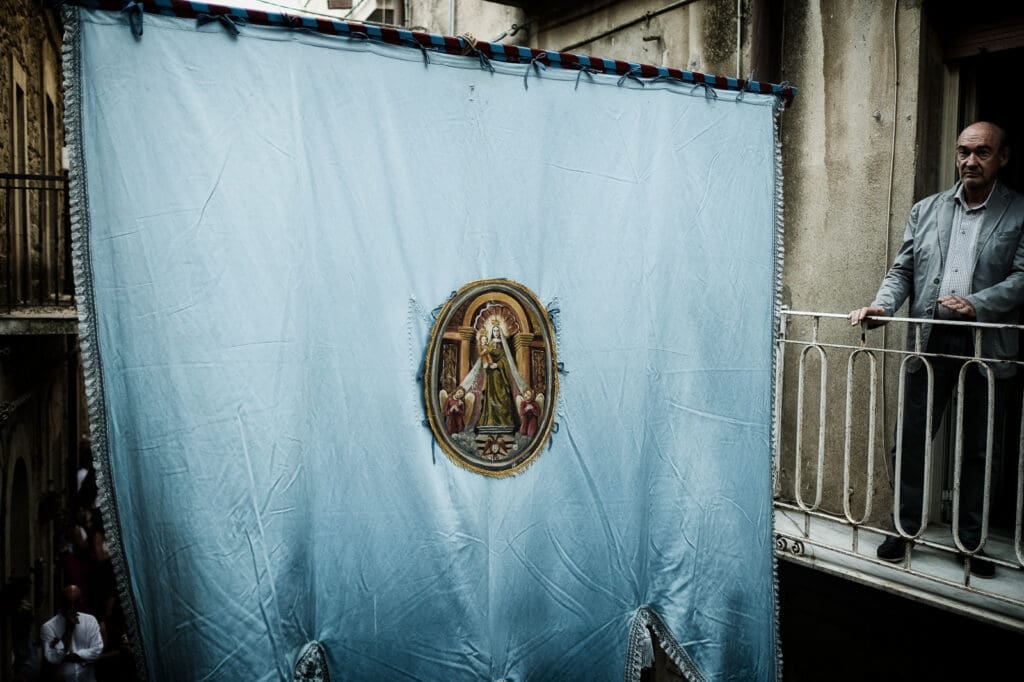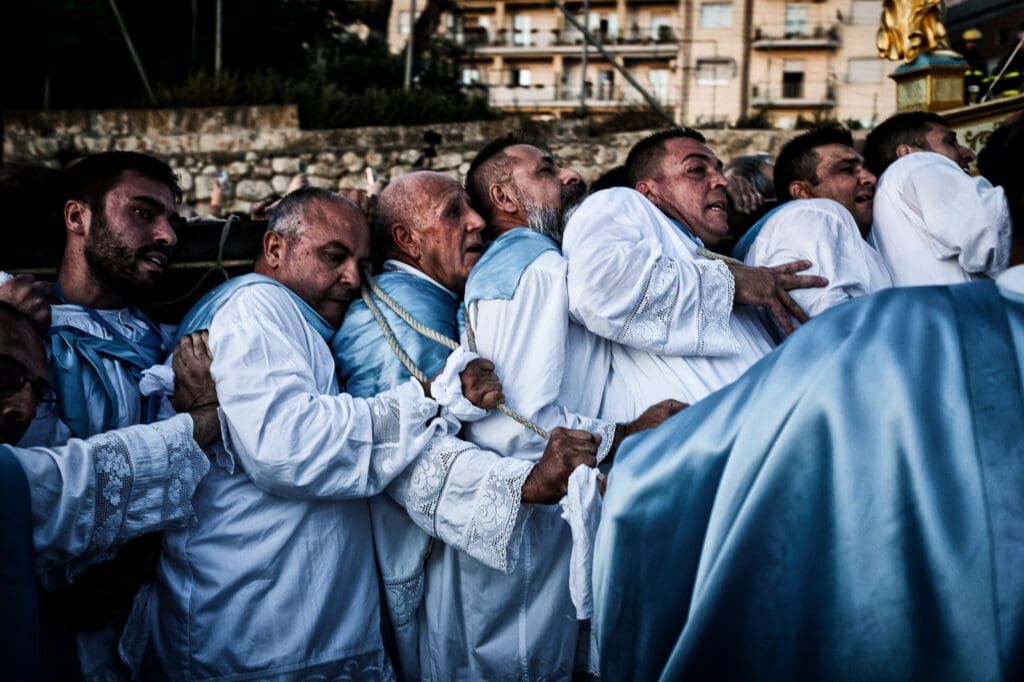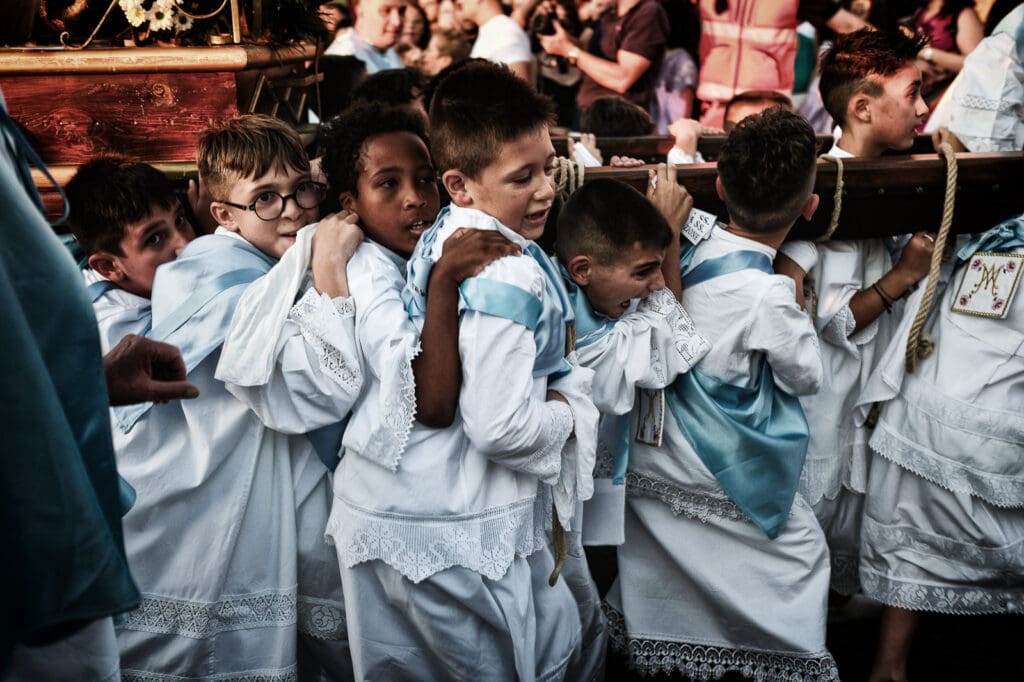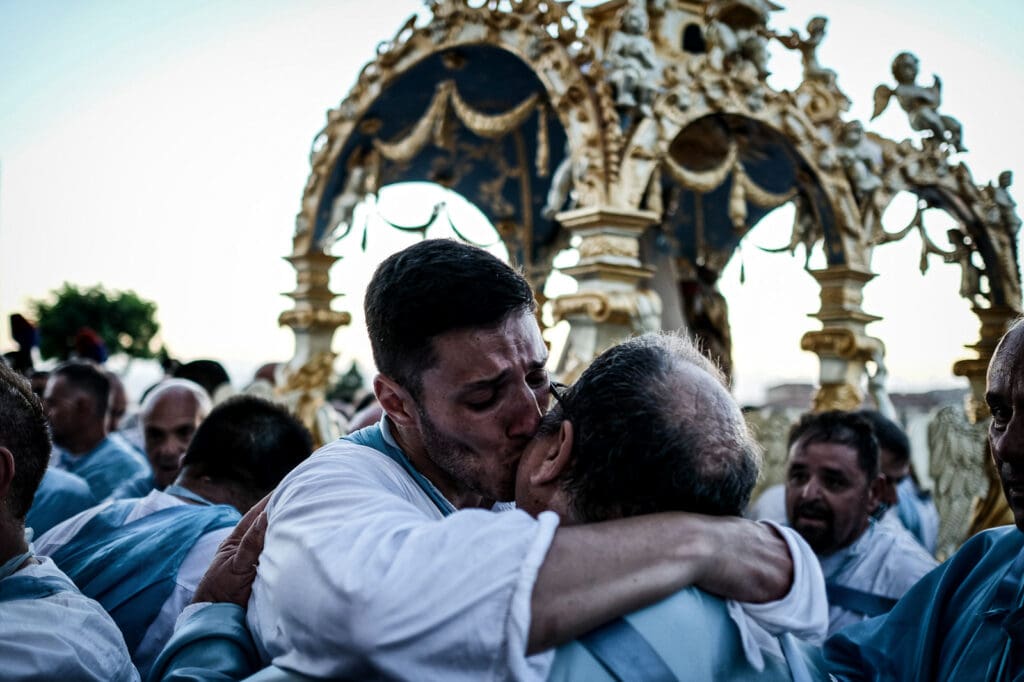It is July 2, and here in the Sicilian hinterland, the heat gives no respite, saps strength, and blurs vision. The car is scorching hot, the lowered windows delude us that the temperature is more bearable. The road cuts through ochre-yellow desert landscapes, printed against a deep blue sky interspersed with rarefied clouds. Here the sea cannot be seen or touched.
After miles, we finally took a detour: we climbed up an impassable mountain lace. The landscape changes and the air also seems to be more pleasant, at times cool. Yes, because Enna, Italy’s highest provincial capital, with its frigid temperatures, hardly seems to belong to Sicily. Yet to see it, perhaps, it represents one of its most authentic expressions. Here the winds of globalization that usually drive away traditions have been blocked by the mountains. One only has to reach the cathedral in the historic centre to immediately realize that something ancient and unchanged by time is about to manifest.

The Brotherhood of the “Ignudi”
Men, boys and children wander barefoot around the cathedral, now the Mother Church of Enna. They enter and leave at a brisk pace, all wearing a white sack-like robe, divided into two pieces, with embattled edges, a pale blue satin cape with an effigy of Mary Most Holy of the Visitation on the left. Around their necks, always the same colour as the cape, they all have a typical ribbon scapular with the effigy of Mary embroidered once again. They are the devotees and men of the Ignudi confraternity of Our Lady of the Visitation, deputed to the celebrations of the patron saint.
The fraternity consists of about 128 Ignudi confreres. One joins after passing a period of novitiate and the age of 21. All others, however, are considered devotees. The confraternity is called the “Nudi” (naked) or “Ignudi” because on June 29, 1412, when the simulacrum of Mary Most Holy of the Visitation first arrived in Enna, it was placed on a wagon and carried on the shoulders of farmers who were reaping and threshing in the nearby countryside. These wore only a piece of cloth that served as a loincloth to cover their nakedness.


An inhuman effort
Every year, on July 2, the Ignudi make the faithful relive that moment, carrying the simulacrum on their shoulders from the cathedral to the hermitage of Montesalvo, crossing the narrow alleys of the centre. All of this is accompanied by the festive marches of the town band and the“sarbiate,” cannon shots that the various neighbourhoods set off as a sign of devotion. In the procession, the patron saint is preceded by the statues of St. Joseph and St. Michael the Archangel, also carried on the shoulders and barefoot by the youngest. On the ascent to the hermitage, the traditional meeting between the ferculum of Our Lady and the wooden statues of St. Elizabeth and St. Zacharias takes place, a reminder of the Visit that Mary made to Elizabeth and which justifies the name “Visitation” of the Feast.
The confreres of Mary Most Holy of the Visitation mount the bajardi, or the outer poles of the ferculum made of seasoned wood, strengthened internally with iron, and covered externally with leather. The bajards have progressive numbers stamped on the side, 124 in all, as many as there are Naked Bearers. These occupy “shoulder posts,” that is, those that are passed down from father to son, from generation to generation. The most challenging places, requiring more physical exertion for the bearers, are twelve and are instead located under the caisson of the “Golden Ship.”
Heartfelt is the emotion of the faithful as the vara, as the people of Enna call the Golden Ship of their Patron Saint, exits the cathedral. Exclamations, prayers and invocations in indecipherable dialects mingle in the air. Until in unison a loud and clear “Viva Marì” is printed in the square kicking off Our Lady’s journey to Montesalvo. Suggestive and at times disturbing is the passage of the Golden Ship through some of the winding streets, such as Market Street, where the vara is taken off the shoulders and dragged almost to the ground with the help of ropes. An inhuman effort can be seen in the faces of the Ignudi, who in addition to not letting go, also have to be careful not to slip on the lava stone flagstones. The pinnacle of difficulty is reached on the climb leading to the hermitage of Montesalvo. Along this last leg, the Golden Ship is supported and carried running to the top. She is seen faltering, at times plummeting, but men with faces distorted by exertion, compressed and breathless, manage not to give way.

From father to son
Touching and meaningful to see the children following their fathers’ example without delay, exhausted, but proud, feeling somehow like heroes. Accustomed to a confused contemporaneity, where technology more than connects people and distances them, where individualism is increasingly exaggerated, seeing these little men united in one effort, following the same steps, makes one think and hope for a kind of resilience. Involving them, and giving them a role is tantamount to handing them the baton of history.
Upon reaching the Montesalvo Church, the gates and doors close, leaving the faithful outside. The Ignudi with sweat-soaked uniforms, reddened eyes, and feet the same colour as the streets, abandon themselves exhausted at the feet of Our Lady: some pray, some let go of tears, and some close themselves in an embrace. The air exudes weariness and bliss. The Patroness is stripped of the votive gold covering her and placed on the main altar of the hermitage, where she will remain as the guest of her two cousins, Zacharias and Elizabeth, for about 15 days before being taken back to the cathedral in a procession similar to the outward journey.
Manifestation of deep faith or simple folk tradition? I have always been attracted to the mysterious side of life, to religions and how human beings marry and use them. So regardless of the answer, it is certain that on July 2 in Enna we return to our origins, without losing sight of the future, where the boundaries between sacred and profane, spirituality and popular participation, religious and secular worlds, break down to leave room solely for heartfelt collective emotion.


